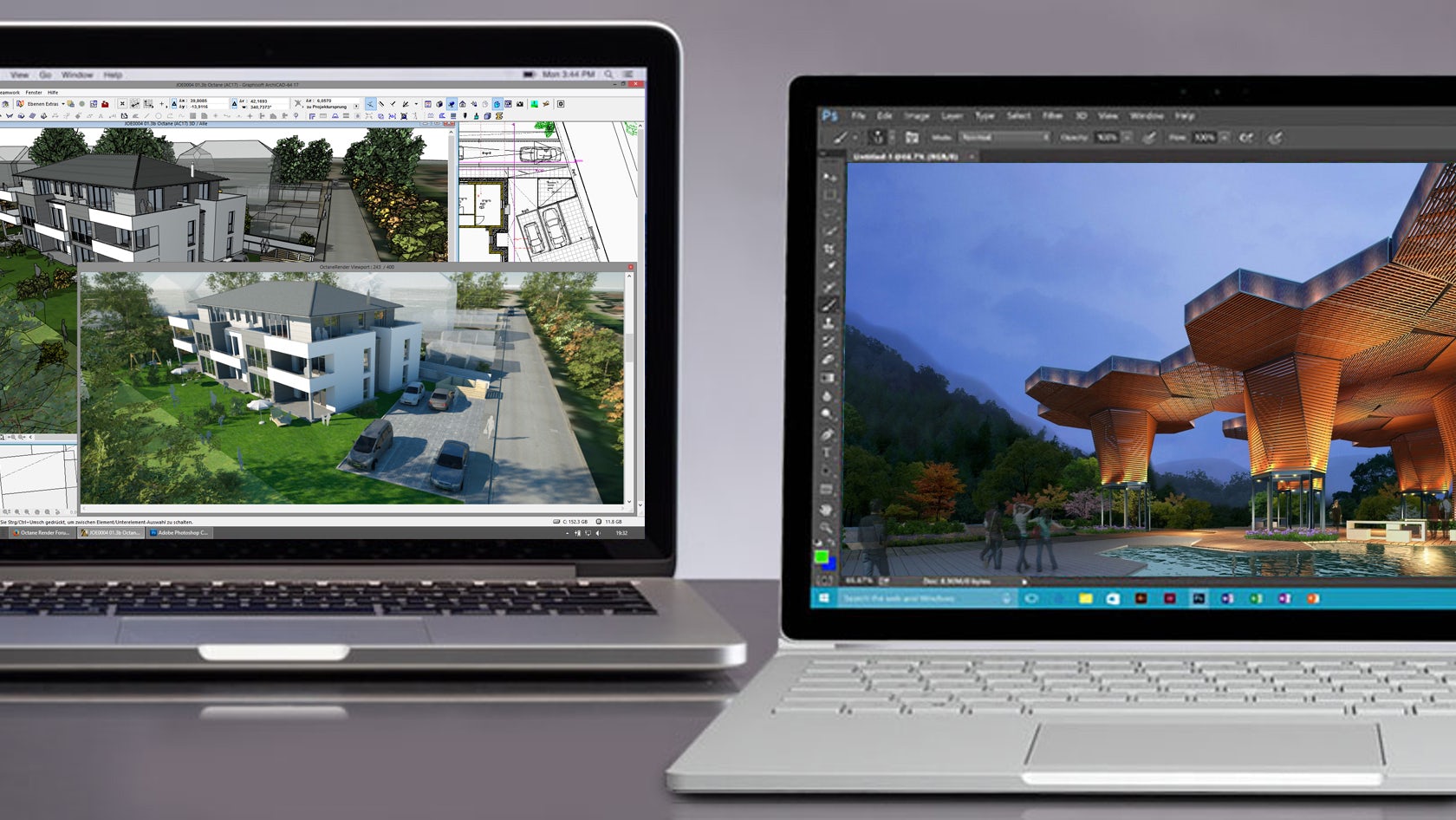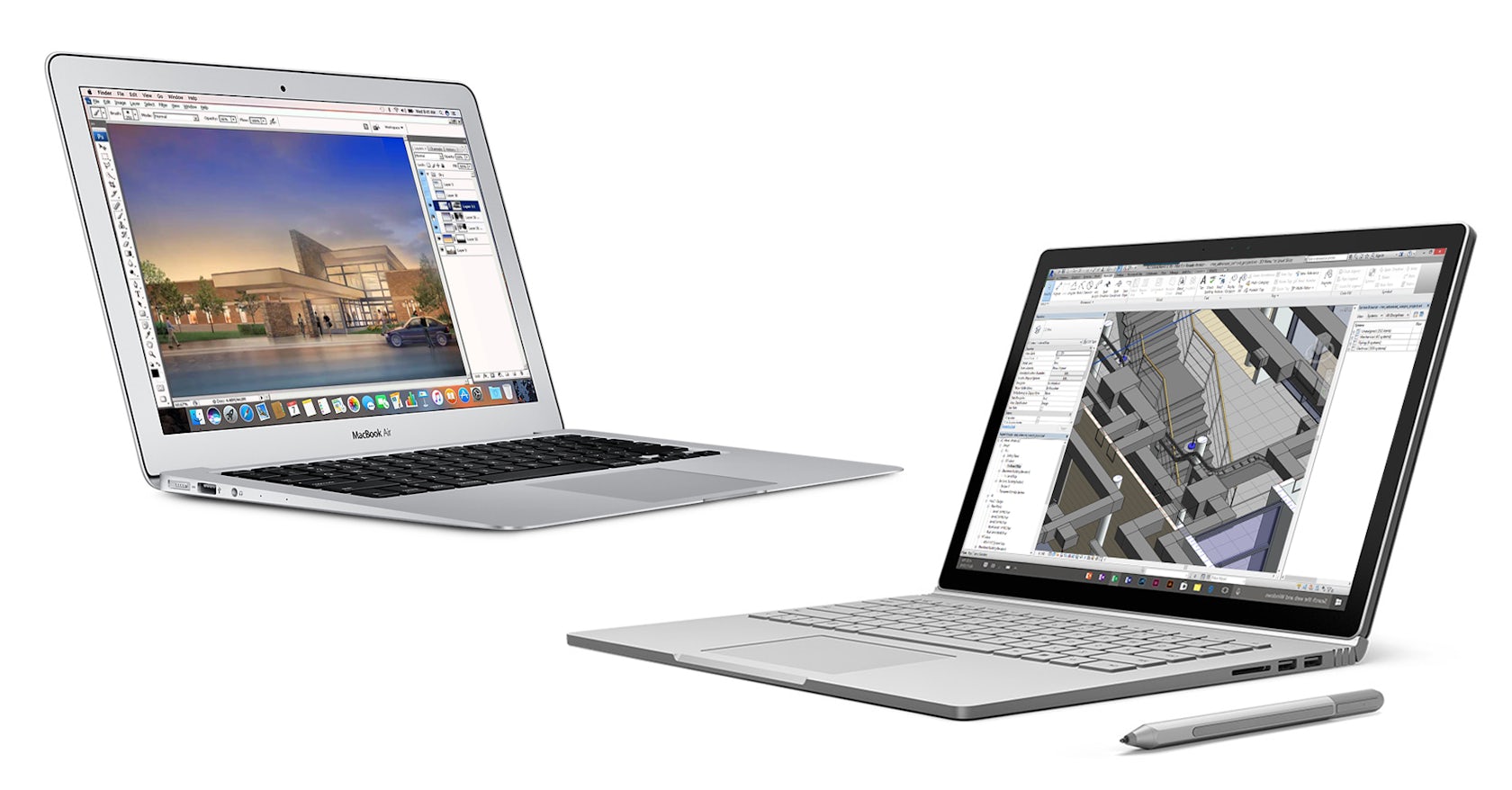Architizer’s Tech Directory is a database of tech tools for architects — from the latest generative design and AI to rendering and visualization, 3D modeling, project management and many more. Explore the complete library of categories here.
Architizer Journal is reader-supported. When you buy through links on our site, we may earn an affiliate commission. Learn more
It’s a question that has attracted unending debate on forums across the internet for years — not just among architects, but for aspiring design professionals of all kinds.
The perceived finality of selecting a work computer makes this a difficult choice, particularly for students just starting out. The computer you use from the beginning of your architectural career will be the one you get used to, and once you are familiar with it, there is a natural resistance to change. As you master the computer’s native software, navigate its technical quirks and learn to love your hardware, it’s quite possible that you will use that type of computer for the rest of your life in architecture.
This may sound dramatic, but there is no denying this is a big decision — take a breath and read on before you decide …
Build Quality
The question of build quality is a crucial one for architecture students and practicing architects alike, as we spend our days running between home, office, coffee shop and café. Our laptops have to survive the journey along with us, so it is essential to buy a computer that can withstand the rigors of daily life.

Left: Macbook Pro; right: Microsoft Surface Book; image via PCMag UK
There is no clear-cut answer when it comes to the build quality of PC laptops, since there are many brands and models available, but among the best is the Microsoft Surface Book 2, which is built with a light magnesium chassis and an innovative “Dynamic Fulcrum Hinge” to keep it balanced at any angle. Other, cheaper PCs with plastic-based outer shells possess a certain flexibility that can provide a cushioning effect if dropped, but they have a tendency to crack and get scratched up over time.
Ultimately, though, this is one area where the MacBook Pro is unbeatable. Apple’s flagship laptop is built with a unibody aluminum chassis, with no inconsistent gaps or joints that can result in creaking or torsional yielding. Using light aluminum means the MacBook has a great strength-to-weight ratio, and its sandblasted exterior shell minimizes the aesthetic impact of grazes and scrapes. If build quality is a top priority for you, Mac might be your best choice.

Revit can now be run on MacBook on your browser using Frame; image via AEC Magazine.
Software Compatibility
Historically, while Apple’s OS runs perfectly with its own hardware, this closed system led to a more limited choice when it came to software — a fact that has long been a drawback for architects. In the past, big software developers like Autodesk and Bentley created CAD software solely for PC, while Mac users were limited to (the admittedly excellent) ArchiCAD or Vectorworks for their drafting needs.
Things are now changing, with certain major players now viewing Apple’s large user base of professional designers as a market they can’t afford to ignore. Autodesk now offers AutoCAD for Mac, and in 2015 it became possible to run Revit on your Apple computer, too, but with a catch — to do so you must use Frame, a platform that delivers Windows applications and work-flows from the cloud, to run Revit within a browser. This key BIM program is still not available natively, but if you have Frame, perhaps it doesn’t need to be.

Autodesk’s offerings for Mac. Frame is needed to run Revit, Inventor and Inventor LT; image via Autodesk
The other thing to note here is that you can actually run Windows in its entirety on your MacBook with the help of Boot Camp and Parallels, partitioning your hard drive and effectively giving you the best of both worlds in terms of software compatibility. This is not possible in reverse, so Apple appears to hold an advantage over PCs in this respect, but it comes at a price. We’ll get on to that next.
Price
It is generally accepted that Apple products are premium products, and their high price repels many people from purchasing them — particularly architecture students and young professionals on a budget. This is true, but there are plenty of high-end PCs on the market, too — ultimately, it comes down to choice, and there is a much larger range of price points for PCs.
“A lot of the hype about the Mac laptops comes from the fact that the entire Mac series is in the high range,” says Abhimanyu Pallavi Sudhir on Quora. “Windows laptops run from a $60 Stream to a $1,000 Thinkpad to a $3,600 Alienware laptop. Macintosh laptops run from $900 to $2,000.”

Lenovo’s Thinkpad Yoga 260; via Notebookcheck
To create a more comparable scenario, Sudhir compared specific models at the same price point — a $1,300 Lenovo Thinkpad Yoga with a $1,300 MacBook Pro with retina display. You can check out his full analysis here, but his takeaway is as follows: The PC wins for the processor, screen finish, keyboard, trackpad, energy consumption, casing, customizability, touchscreen and hinge. The Macintosh wins for the graphics, screen resolution, trackpad finish, battery life, weight and thickness.
So, it could be argued that both models in question — Mac and PC — represent good value depending on your priorities. In the end, it seems you really do get what you pay for.
Life Span
While processing power and graphics will dictate the longevity of a laptop for many, these aspects won’t matter if your computer’s build quality is low. This is where a MacBook comes into its own again — the robust nature of Apple’s hardware means that it will outlast the majority of PCs, and this in turn makes its hefty price point appear more palatable.
Conclusion
The seductive aesthetic qualities and robust build of a Mac versus the greater compatibility and comparatively lower price of a PC make this a difficult choice, and as much as you may want a definitive answer, we have to disappoint you! This all comes down to personal preferences.

If ArchiCAD or Vectorworks is your go-to CAD application, a MacBook is a reliable — not to mention stunning — option that has the capability of paying for itself over time thanks to its incredible build quality and stable OS. On the other hand, if you have specific preference pertaining to processing power, graphics or price, a specialist PC may well prove the better option.
“Choosing the Windows platform also gives you a lot of choice,” says Sudhir. “Do you want durability and features? Get a Thinkpad. Do you want durability and a great trackpad? Get an Elitebook. Do you want sleekness, screen resolution and design? Get an Ideapad. Do you just want a cheap PC? You’ve got a ton of options … Where the PC loses out, there are other PCs that win over the Mac.”
So there you have it — PC offers a great range of options and the ability to customize, while Mac continues to excel in specific areas. Neither is the wrong choice — all that matters is choosing a computer that complements your personal work-flow.
Which computer do you use? Are you considering a change from PC to Mac or vice versa? Let us know in the comments on Facebook!
Architizer’s Tech Directory is a database of tech tools for architects — from the latest generative design and AI to rendering and visualization, 3D modeling, project management and many more. Explore the complete library of categories here.









